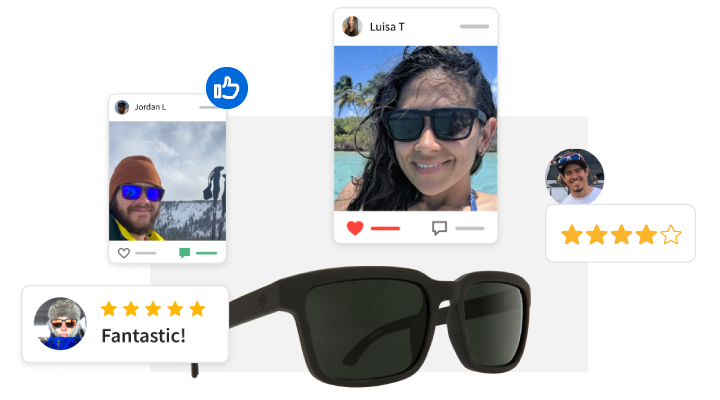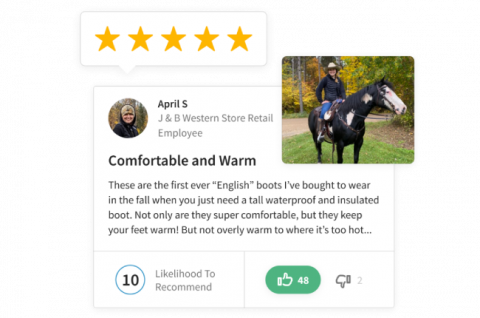How to build a UGC strategy
How to build a comprehensive user‑generated content (UGC) strategy
August 15, 2022

The best way to get someone to buy your brand’s product? Word-of-mouth recommendations from trusted friends and family. The next best thing? User-generated content (UGC). The truth is that over 85% of people find user-generated content to be more influential than brand content.
This guide will give you the facts and figures about what UGC is, how to get more of it and how it can boost awareness and sales for your brand.
The breakdown:
- What is user-generated content?
- Benefits of user-generated content
- Types of UGC
- How to create a UGC strategy
- How to source user-generated content
What is UGC (user-generated content)?
User-Generated Content is defined as any type of content that has been created by unpaid contributors. It can refer to pictures, videos, product reviews, blog posts and everything in between. It’s the user talking about a brand rather than the brand talking about itself.
Chances are, you’re probably familiar with this content and might even already harbor some preconceived notions about the ways that marketers collect and leverage user-generated content. Maybe UGC makes you think of influencer product promo posts with affiliate sales links or low-quality and sometimes even unverified product reviews.
When it’s done right, UGC can provide compelling and polished content from the consumers who know your brand and products firsthand— not to mention a sizeable return on investment.
Benefits of user-generated content
Beyond being a low-cost content opportunity and meeting new industry standards of what your products look like IRL— UGC usage has tons of additional and significant benefits for brands.
It builds trust with consumers.
Authentic (unpaid) UGC puts your customers at the center of your brand, which humanizes your marketing efforts. Something we could all use a little bit more of these days. Leveraging user-generated content keeps people perceiving your brand as one that values the voices of its customers.
That perception isn’t a surface-level thing—63% of consumers would buy from a company they trust and consider to be authentic instead of its competitors.
It’s genuine.
Consumers find UGC 9.8x more impactful than influencer content when making a purchasing decision. So ensuring that your content showcases real-world people using and talking about your brand and products is key.
This kind of content gives consumers what they are continuously craving, human connection rather than picture-perfect curated content that they can’t relate to.
Take for example, Airbnb’s recently launched ad campaign (the first they’ve run in over five years). The TV ads featured still photos from real groups of people on their post-pandemic getaways. By centering their consumers, they achieved an incredibly low-cost, high-impact, tug-at-your-heart-strings type of campaign.
It boosts engagement and sales.
In the midst of our modern attention economy, engagement is everything, and it’s not always easy to come by. When companies generate and share user-generated content on social media channels, they get 28% higher engagement compared to standard company posts.
On average, 55% of customers engage with UGC before making a purchase, and that number doesn’t seem to be decreasing anytime soon. Second only to a direct word-of-mouth recommendation, authentic and honest UGC, in the form of product reviews and photos, has the most impact on buying decisions.
Types of user-generated content
Now that you know why UGC can be influential, it’s time to start exploring the different forms it can take a bit more deeply. There are two main types of content that brands typically use to boost awareness and sales:
1. Visual UGC (images and videos)
This is the most common type of UGC. Videos and photos, typically uploaded to a social site or a UGC dedicated platform, that tag the brands and products featured.
ExpertVoice allows brands to collect authentic image and video UGC from vetted and credentialed industry pros and trustworthy recommenders to source and re-use without any creator contracts to worry about.

2. E-Commerce product reviews and ratings
Reviews and ratings are left on e-commerce product pages and are a major driver of sales success. A significant 70% of consumers consider UGC reviews or ratings before making a purchasing decision. And at least 41% of them will read four to seven UGC reviews to gain important insights on a product.
On-site consumer reviews can increase conversions by 74%. Think about it, when’s the last time you purchased an item with no customer reviews to back it up? Chances are it’s been a while. These days though not all product reviews are made equal, from mere ratings with no description to full-on fraudulent reviews, it’s increasingly important to find tools that help you source in-depth product reviews from people who really know their stuff.

How to create a UGC strategy
Get clear on the goals and the purpose behind your UGC campaign. Here’s a few examples of what a UGC campaign can be used for:
- Launching a new product / line
- Boosting brand awareness
- Promoting a particular campaign
- Prompting people to give product feedback
Decide on what type of UGC fits your campaigns needs. As we covered, UGC can take many different forms—text product reviews, ratings, images, selfies, long or short-form videos, and unboxing videos. The content world is your oyster.
The important thing is that you tie it back to your ultimate goal and your target audience. What channels do they spend time on? What content do they like to see? Run a campaign based on those themes and in the places that they spend the most time.
Clearly plan your strategy.
Now that you’ve landed on the who and the what of your UGC strategy it’s time to lay out your how. Plan out your strategy with a couple of key things in mind; duration of campaign run time, measurable goals to hit along the way (for example, number of submissions or impressions on a social post). Align your timeline with your goals and get to work collecting content that meets your needs.
How to source user-generated content
After you’ve set your goals, narrowed in on the types of content you want to collect, and have a deep understanding of the audience you want to resonate with—it’s time to start finding the content. Here are a few ideas to get you started and set you apart.
Motivate key customers to create UGC.
Rather than paying for product placements, diluting the purpose of building brand authenticity with UGC, you can inspire existing key consumers to post about your brand and share their firsthand experiences with the world. More than half of consumers wish that brands would tell them what type of content to create and share. With that in mind, it’s important to find ways to explicitly spell out what you’re looking for.
In order to do that, engage them at the most important stages of the buying journey and create calls to action for your consumers to create UGC along the way.
- Post-purchase follow-up.
- When they receive their product.
- After they’ve had a chance to see the impact your product has.
This can be an email follow-up asking them to leave a simple review or rating or as personalized as a physical note that comes with their e-commerce purchase, prompting them to share an image and include certain hashtags or film an unboxing video with how-to steps. These are relatively low-lift examples, but depending on your brand’s buy-in on a UGC strategy, it might be worthwhile to work with a brand advocacy tool to connect with more targeted personas at scale.
Incentivize users.
Oftentimes, the opportunity to partner with your brand and be featured on your brand’s social channels or website can be incentive enough. But gamifying the process or adding some extra way to sweeten the deal for consumers (without sacrificing authenticity) can be an effective way to boost submissions. Contests, free product sampling, community membership or offering discounted prices on your products are all great ways to garner more content.
Find platforms that allow you to connect with consumers at scale.
Rather than juggling 10+ different tools and tracking your contributors with piecemeal spreadsheets, find a solution that allows you to connect with creators and collect and share their content.
The Instagrams and TikToks are an obvious place to start (and an important part of the puzzle), but if you’re looking for a space to connect with a more niche set of micro-influencers directly and manage their advocacy of your brand where they upload content, it’s probably time to start looking for a new kind of platform. ExpertVoice is a platform for real-world experts to connect directly with the brands they love, get trained on their products, test them out and share their UGC in whatever form they’d like. From in-depth product reviews from a verified industry expert, images for social sharing or product review videos.
Get more UGC in your back pocket with ExpertVoice.
With people spending an average of 2 hours and 24 minutes a day on social media, there are plenty of opportunities to get your brand on people’s screens and minds. But, with everyone vying for attention, consumers are selective about what they pay attention to and what they tune out. 31% of consumers say that advertising that features UGC is more memorable than traditional ads.
Yet these days, even user-generated content can start to feel redundant. That’s why it’s essential to set your content apart. Find out how ExpertVoice can help you source a new kind of UGC—from real-world experts with infectious levels of passion. No paid promotions, no creator contracts, just great content created by even better people. Find out more today.




